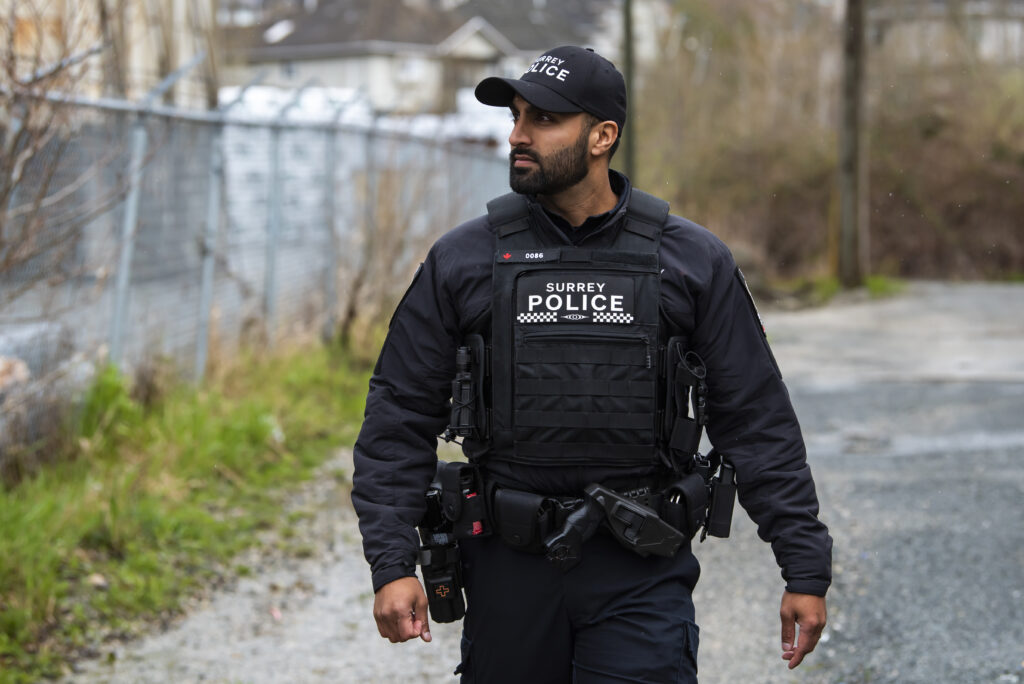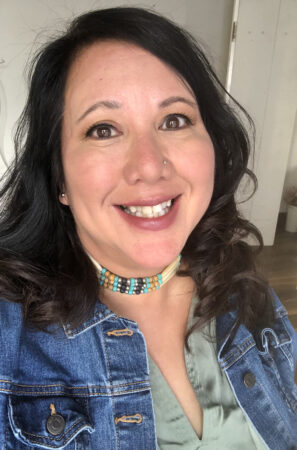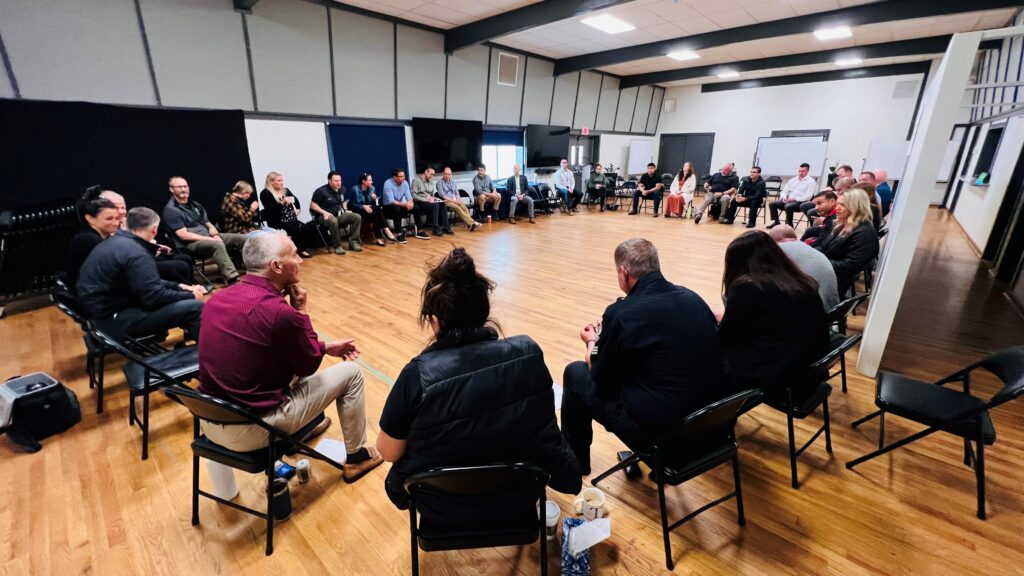
Features
Circles of Understanding: Surrey Police take part in new Indigenous cultural training
November 20, 2023 By Brittani Schroeder
 Sgt. Brendan Charna. Photo credit: Sarah Moldenhauer of Sarah Jane Photography.
Sgt. Brendan Charna. Photo credit: Sarah Moldenhauer of Sarah Jane Photography. In the spring of 2023, the Indigenous Relations Unit of Surrey Police Service (SPS) hosted their Circles of Understanding. You may be asking yourself, “What is that?”
Blue Line was able to speak with Deputy Chief Constable (DCC) Michael LeSage and Insp. Kelly Wong of SPS, and Tina Taphouse, an Indigenous artist, about how law enforcement agencies can authentically connect with local Indigenous peoples while also understanding their history and why there may be a negative reaction to police officers. The goal was to foster positive relationships with Indigenous people they encounter and serve every day.
Tina Taphouse’s story

Tina Taphouse. Submitted photo.
Tina Taphouse is Interior Salish from St’at’imc Territory, located in Lillooet, B.C., whose parents were both residential school survivors. Taphouse herself is a Sixties Scoop survivor; her mother made the decision to give her up for adoption as a newborn so that she would not have to attend the Kamloops Indian Residential School (KIRS).
Taphouse feels like she lives “in the middle”, because she grew up in a white privileged world, and now fully embraces and lives in her Indigenous Culture and Community. “Sometimes I feel lost, because I don’t feel like I fit into either world. A lot of Sixties Scoop survivors feel this way.” She shared that some survivors were given good adoptive/foster families, but others were met with bad home situations. For some, when they reconnected with their birth families, they were not accepted. “It’s difficult, and it’s something we live with.”
Meeting her birth father in 1994 and her birth mother in 2012 was overwhelming for Taphouse. She and her mother grew very close. They only had nine years together before she passed away in 2021.
Taphouse has been presenting her experiences and life story to schools and organizations for several years. This year, she partnered with SPS to create the Circles of Understanding. It was quite the journey for Taphouse to let law enforcement into her life, though. “It goes without saying that Indigenous peoples have certain feelings towards the police. Even today, we see events in the news that don’t sit well with our community.”
Taphouse believes that it’s her Ancestors who have given her a voice to speak out on behalf of other Indigenous peoples who may not have the opportunity or courage to do so.
Creating the training
There is a policing standard that comes from the B.C. Provincial Policing Standards, mandated by the director of police services under the B.C. Police Act, that requires all police services to develop Indigenous cultural safety training. Through many discussions, it was clear to both Insp. Kelly Wong and Cst. Steve Hanuse – an Indigenous officer working in the Indigenous Relations Unit – that the standard was just the catalyst for something more. They wanted to provide additional training that would be engaging to all members, rather than just having them check a box on their training list. “We wanted it to be meaningful,” said Insp. Wong.
It is Insp. Wong’s belief that, in order for training to really bridge the gap, they would need to engage members on an emotional level. “Once they understand the ‘why’, members will be more open to listening and learning from everything that follows.”
In order for officers to know what the community needs, they must get out there and ask them about their priorities.
Cst. Hanuse contacted Taphouse with the idea of the Circles of Understanding, which would aim to provide officers with a better understanding of the history of Indigenous peoples. These circles would also educate members on why police uniforms might be negatively perceived by Indigenous people and how inter-generational trauma can lead to mistrust, fear and/or anger against police.
“When Steve asked me to be a part of this, I didn’t even hesitate to say yes,” said Taphouse.
For DCC LeSage—who spent 25 years with the RCMP before joining SPS and who is Indigenous himself—and for Chief Norm Lipinski, the Circles of Understanding were a high priority because Indigenous voices and their perspectives have been underrepresented in police training for too long. SPS and its leadership team are “committed to community engagement and connection, and in order to get that, there needs to be a level of trust both ways,” said DCC LeSage.
The Circles of Understanding were held over the course of four mandatory training days. Eight sessions were hosted, each running at approximately 2.5 hours. SPS was able to train 245 officers – 85 per cent of their membership.
At the beginning of each session, each SPS member would share who they were, where they came from, and their past experiences with Indigenous peoples. As SPS is comprised of experienced officers coming from over 28 different policing agencies across Canada, some officers had never had prior dealings with Indigenous communities.
Cst. Hanuse would talk about the history of Indigenous people, followed by speaking about his own journey and experiences. Taphouse would finish with the history of the Sixties Scoop and her story. They sat in a large circle for a reason; in a circle, no one is ahead of you, behind you, above you or below you. In law enforcement, members are assigned a rank and position; in a circle, you can be open with everyone all at the same time.

Photo credit: Surrey Police Service
The importance of understanding
Insp. Wong received a lot of feedback from members after attending the Circles of Understanding. Most were not prepared for the level of raw emotion that was shared. The officers came away from these sessions with a better grasp on why First Nations communities might react a certain way when a police officer arrives. “With this understanding, they’ll be able to adapt how they present themselves and how they speak with these communities,” said Insp. Wong.
Taphouse encourages members of law enforcement to go into the community, attend Truth and Reconciliation events and Indigenous Peoples’ Day, Pow Wows and ceremonies, to connect with Indigenous people. “Let people know you’re open to learning and creating a bond, while also acknowledging the land you are on. All of these events are open to the public.”
In DCC LeSage’s view, trauma-informed and culturally-informed policing creates better police officers and lends to better community policing. He also recognizes that Surrey has one of the largest Indigenous populations in B.C. that are not living on a reservation. He agreed with Taphouse, stating that in order for officers to know what the community needs, they must get out there and ask them about their priorities. “I have personally never met a community that wasn’t willing to work with or help the police in certain areas, but you need to build the trust first. That’s community policing at its finest – dealing directly with the community,” he said.
Insp. Wong is determined to continue this type of training for SPS members. This year, they hosted the Circles of Understanding. Next time, it could be a site visit to an archaeological dig that is being conducted by Indigenous communities, or it might be a visit to a First Nation to meet with the elders. “No matter what, it will continue,” Insp. Wong stated.
Taphouse knows this reconciliation will not happen overnight but urges officers to take the time to learn and create a connection. DCC LeSage knows that part of the reconciliation is a continuing education of the past for their members. “Even if this knowledge gives our officers an extra minute or two of understanding while speaking with someone, to hear their side of the story rather than coming forth with judgement, it will be for the better.”
As Cst. Hanuse says, “There has been a lot of acknowledgements of truth; there’s recognition of the historical experiences. But are we doing a good job on the reconciliation side? What does the path forward look like? What are we doing to reconcile?”
In law enforcement, members are assigned a rank and position; in a circle, you can be open with everyone all at the same time.
Insp. Wong agrees with him. For her, building relationships with the First Nations communities is just the start of reconciliation. “We need to listen to them, learn what they want from us and what they expect from us. Then the onus is on us to meet those expectations to provide them what they’re asking for. We are a service provider, and we are here to serve them,” she said.
Parting words of advice
For other police services who are looking to create a similar training for their members, Insp. Wong strongly suggests that this training is not something to develop lightly.
“You need to recognize the trauma that you’re asking this speaker to revisit every time they share their story. You need to find the right person who is willing and open to speaking, because you don’t want to cause them any more harm. You also need to remember that it is not up to you to dictate what the learning should be. It’s up to the First Nations community to decide what they feel is most important for your officers to learn.”
As a last thought from Taphouse, she believes that when we say Truth and Reconciliation, we are still in the truth part. “Truth is listening to our stories and histories. Our healing is ongoing, and it could take three to four more generations before we are all healed. Right now, any tiny step helps. So, to all law enforcement, open your heart and maybe you’ll be able to create a bond going forward.”
Print this page